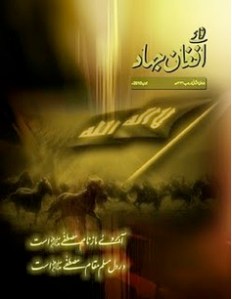
The image is the cover of the June 2010 issue of the magazine Nawa-i-Afghan Jihad. The element that holds center stage is the horse motif. The horse is an important symbol in both pre-Islamic Arabia and Islamic culture, as evidenced by pre-Islamic poetry, hadiths (prophetic traditions or reports) and other genres of literature ascribing horses with the positive qualities of chivalry and bravery in battle. For example, the beginning of the Qur’anic sura 100 talks about “running horses” that appear as galloping through the world toward the final goal, namely, Judgment Day. Horses are also symbolic of the first generation of Muslims and that generation’s successful military campaigns, and thus are often employed to evoke specific Salafi religious sentiments with regard to the military victories of Muhammad and his companions. Thus, the horse motif places current jihadi activities within the same unfolding dialectic as the jihad of early Islam.
The banner in the image bears the first part of the shahada (Islamic testimony of faith holding that there is no god but Allah and that Muhammad is his messenger) and constitutes the joint symbol of vengeance and revolt that traces its roots to prophetic times. According to hadith, the black flag was the battle flag of the Prophet Muhammad and it was carried into battle by many of his companions. The image of the black flag has been used as a symbol of religious revolt and engagement in battle (i.e., jihad). In the contemporary Islamist movement, the black flag with the shahada is used to evoke notions of jihad and of reestablishing the Islamic Caliphate.The caption reads: “and Muslim countries are the place of the Prophet.”
 Skip to content
Skip to content
